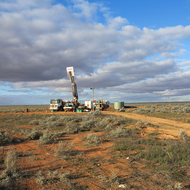A pioneering project by GSWA to discover what lies beneath the great Nullarbor Plain has been presented at the Rodinia 2017 Conference in Queensland.
| Date: | Tuesday, 25 July 2017 |
|---|
A geoscience expert from the Department of Mines, Industry Regulation and Safety (DMIRS) has recently returned from a trip to Townsville in Queensland where she delivered a keynote speech at the Rodinia 2017 Conference.
Geological Survey of Western Australia (GSWA) Division’s, Dr Catherine Spaggiari, said this flagship conference is part of the International Geoscience Programme (IGCP) Project - ‘Supercontinent Cycles and Global Geodynamics, IGCP 648’ - and builds on previous Rodinia meetings, held every four to five years.
“Rodinia brings together 60 to 70 international experts from a range of geological disciplines to present and discuss the latest in the geodynamics of supercontinent assembly and breakup, and related geological phenomena including palaeomagnetism, mineral deposits, and past occurrences of subduction and mantle plumes,” Dr Spaggiari said. This information is captured in global databases available for public use.
As keynote in the ‘Assembly of Australia in supercontinent cycles’ session, one of seven themes covered at the conference, Dr Spaggiari’s presentation highlighted the results of GSWA’s pioneering work in the Eucla basement.
“The Eucla basement stratigraphic drilling project was established to investigate the greenfields basement provinces that lie between the eastern edge of the Albany–Fraser Orogen and the western margin of the Gawler Craton in South Australia. Funded through the Exploration Incentive Scheme (EIS), we secured high-quality diamond drill cores of the basement from well-defined geophysical domains enabling greater insight into the geology beneath the Eucla Basin and Nullarbor Plain.
“It’s all brand new information that is significant in terms of mineral prospectivity and it was a privilege to be able to share our learnings of this part of the world with such an international group of experts,” concluded Dr Spaggiari.
For more information about DMIRS’ Eucla Basin project, please visit our website.

